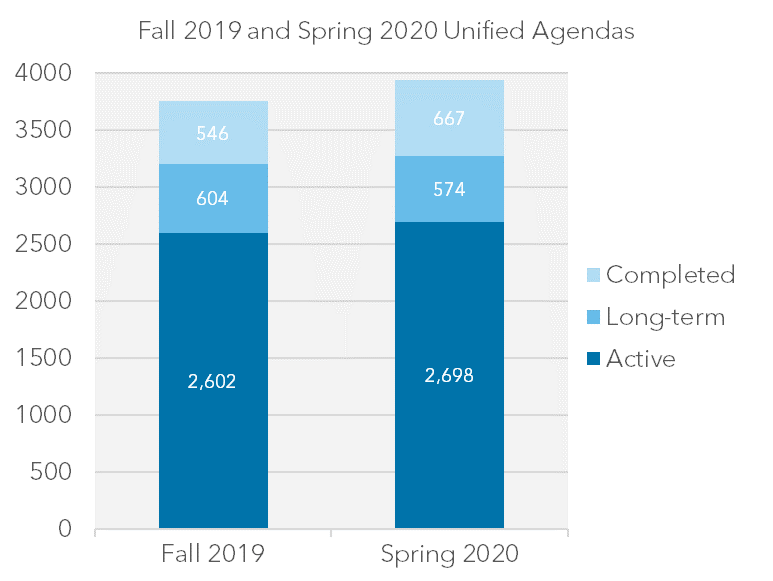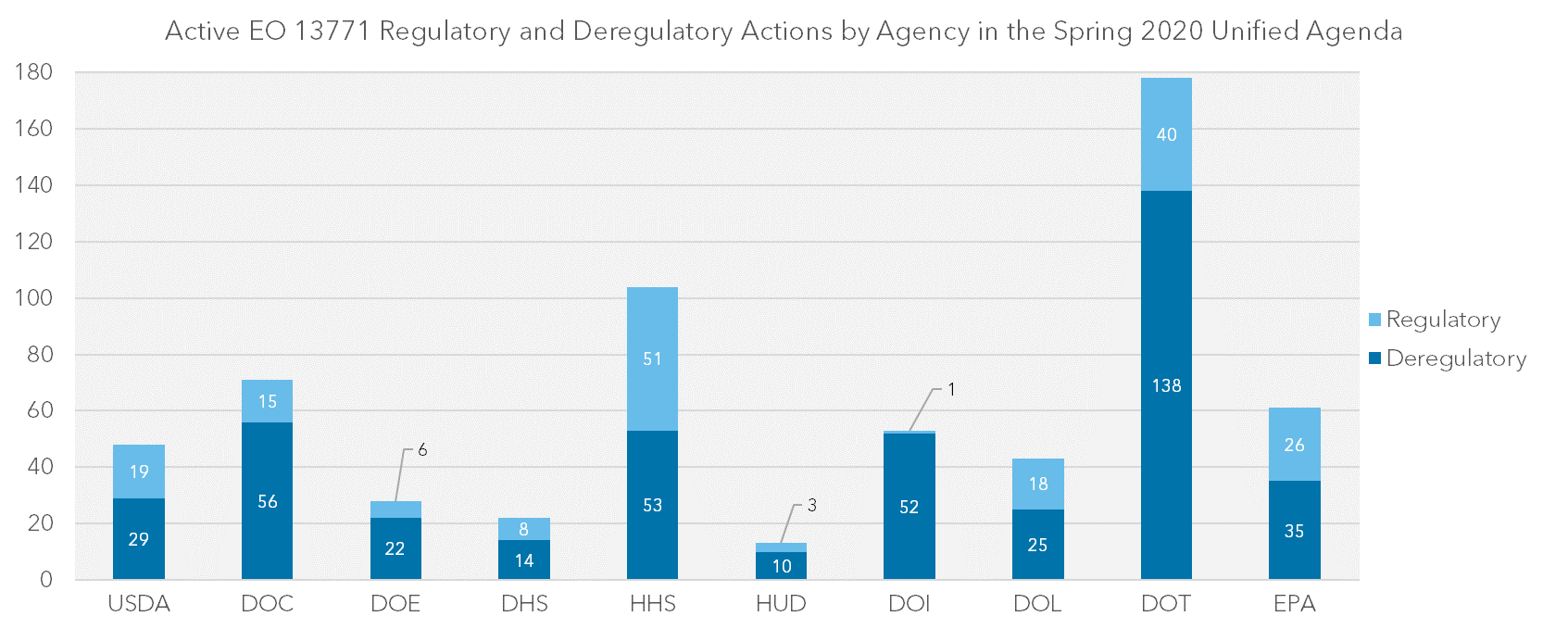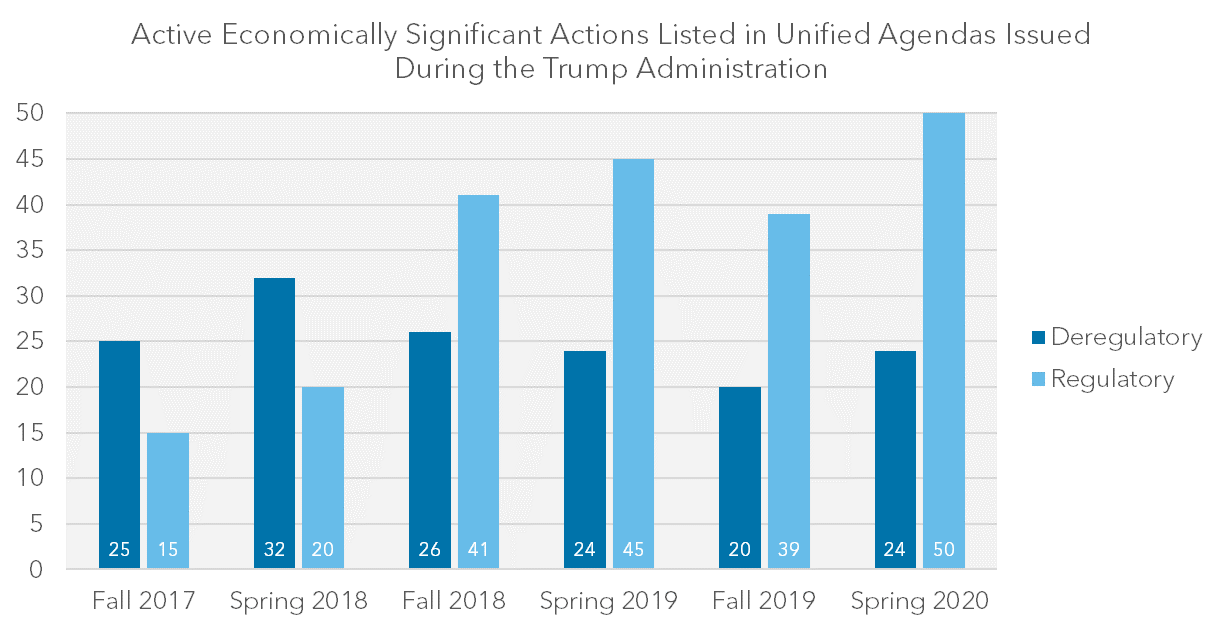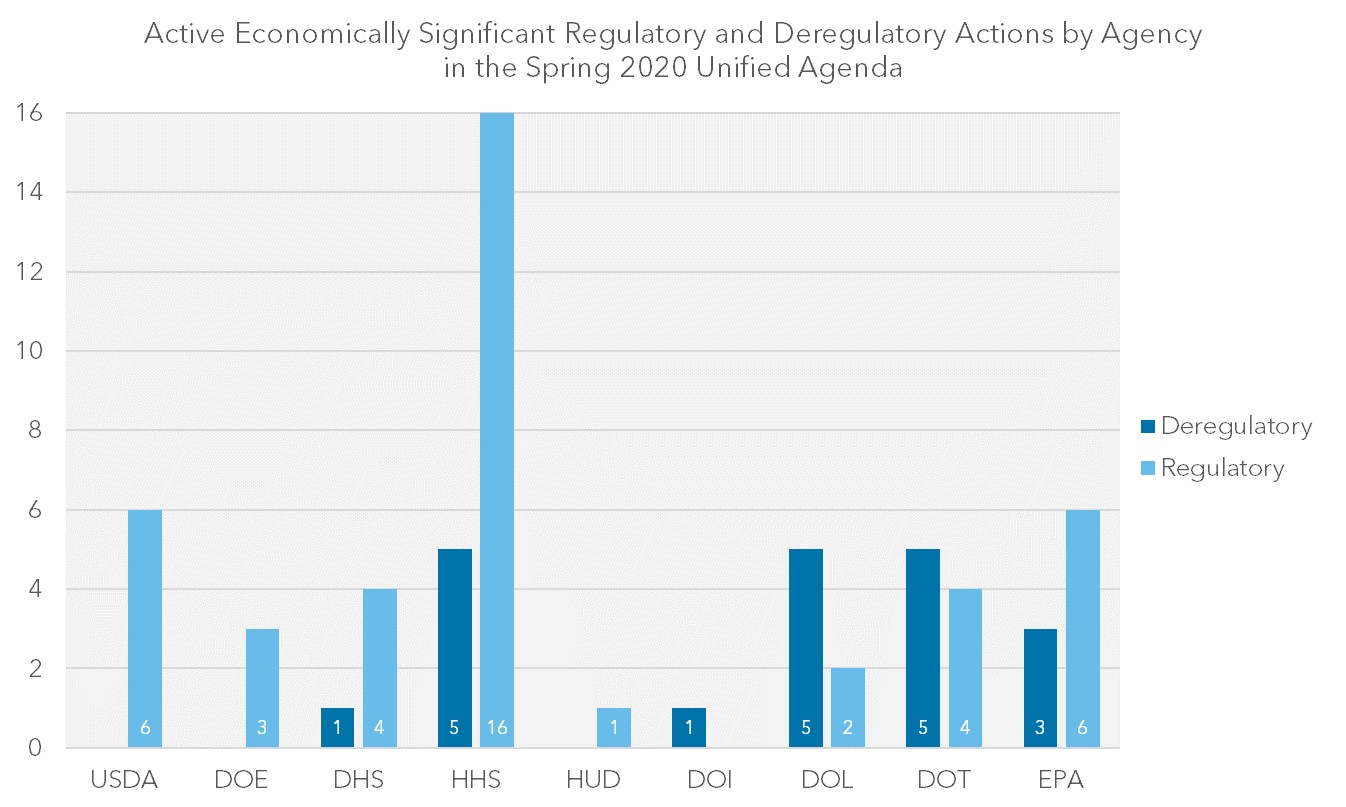Download this Commentary (PDF)
Download the complete list of economically significant actions not designated as either "regulatory" or "deregulatory" in the Spring 2020 Unified Agenda (PDF) (Excel)
On Tuesday, the Office of Information and Regulatory Affairs (OIRA) released its semiannual Unified Agenda of Regulatory and Deregulatory Actions. The Agenda lists all regulatory actions currently being developed by federal agencies. Since President Trump took office, the Agenda also classifies actions as either “regulatory,” “deregulatory,” or otherwise exempt—pursuant to the administration’s Executive Order (EO) 13771 requiring that agencies issue 2 deregulatory actions for every 1 significant regulatory action while operating under a regulatory cost cap.
An initial look at the Agenda’s topline figures might suggest that agencies under the Trump administration plan to continue meeting their regulatory reform targets under EO 13771—collectively planning to issue approximately 2.2 deregulatory actions for every 1 significant regulatory action. However, a breakdown of actions by agency illustrates that this average is primarily driven by the performance of a few outliers with multiple agencies planning to regulate well beyond their 2-for-1 targets. Additionally, for rules expected to have the largest effect on society (i.e., $100 million or more in benefits and costs), agencies are on track to reverse course by issuing an average of 2 regulatory actions for every 1 deregulatory action.
The cumulative results of agency performance in implementing regulatory reform for FY 2020 won’t be available until OIRA releases its annual EO 13771 Report later this year. Nonetheless, the Spring 2020 Unified Agenda suggests that agencies have either run out of low hanging fruit with regards to deregulatory actions or have begun to regulate, on net, to implement the Trump administration’s remaining policy priorities.
Depending on the outcomes of elections in November, many of the rules listed in the Spring 2020 Agenda could face expedited elimination by the incoming Congress under the Congressional Review Act (CRA). Although the COVID-19 pandemic has created additional uncertainty regarding the start date for the review window, a recent estimate suggests that any rules issued after May 13 could be subject to disapproval.
What’s in the Spring 2020 Agenda?
The Spring 2020 Unified Agenda lists a total of 3,939 agency actions, 334 of which are classified as regulatory and 677 as deregulatory. The remaining 2,928 actions are exempt from EO 13771, classified as “other,” issued by independent agencies or otherwise not subject to the requirements of EO 13771. Of the total number of actions, 226 are economically significant.[1]
Actions in the Agenda are also categorized by their stage of development including: active (those with milestones expected within 12 months), long-term (those outside the 12 month window), and completed actions (which includes rules that are finalized or withdrawn). Of the 2,698 actions listed as active, about 22 percent are published for the first time in the 2020 Spring Agenda.
Table 1: Contents of the Spring 2020 Agenda
| 13771 Designation | ||||||
| Stage | Agency Actions | Economically Significant Actions | First Time Published | Regulatory | Deregulatory | Exempt |
| Active | 2,698 | 149 | 601 | 230 | 516 | 241 |
| Long-Term | 574 | 38 | 61 | 69 | 53 | 44 |
| Completed | 667 | 39 | 98 | 35 | 108 | 50 |
| Total | 3,939 | 226 | 760 | 334 | 677 | 335 |
Table 2: Active Regulatory and Deregulatory Actions listed in Unified Agendas under the Trump Administration
| Agenda | Active Actions | Economically Significant Actions | Economically Significant Deregulatory Actions | Economically Significant Regulatory Actions |
| Fall 2017 | 1,977 | 71 | 25 | 15 |
| Spring 2018 | 2,224 | 88 | 32 | 20 |
| Fall 2018 | 2,399 | 118 | 26 | 41 |
| Spring 2019 | 2,587 | 123 | 24 | 45 |
| Fall 2019 | 2,602 | 119 | 20 | 39 |
| Spring 2020 | 2,698 | 149 | 24 | 50 |

Regulatory and Deregulatory Actions by Agency
For agency actions listed as active, regulatory agencies plan to issue an average of approximately 2.2 deregulatory actions for every 1 significant regulatory action.[2] However, this average is primarily driven by outliers like the Department of Interior (DOI)—which plans to issue 52 deregulatory actions and only 1 significant regulatory action—along with a few other agencies deregulating above a 3-to-1 ratio including the Department of Commerce (DOC), Department of Energy (DOE), Department of Housing and Urban Development (HUD), and the Department of Transportation (DOT). The remaining six agencies depicted in the figure below are planning to deregulate at less than a 2-to-1 ratio.[3]

Two Regulatory Actions for Every One Deregulatory Action
A breakdown of economically significant rules provides another useful measure of regulatory activity. The first two Agendas released under the Trump administration contained a greater number of active economically significant deregulatory actions than regulatory actions. A shift occurred in the Fall 2018 Agenda where regulators planned to issue 41 economically significant regulatory actions and only 26 economically significant deregulatory actions. The current Agenda illustrates that agencies plan to issue, on average, just over twice as many economically significant regulatory actions (50) as deregulatory actions (24).

A view of planned rulemaking across agencies provides a closer look at which regulatory actions are driving these results. A few agencies plan to issue no economically significant deregulatory actions while still planning to issue large regulatory actions including: USDA, DOE, and HUD.
DHS and HHS plan to issue approximately 4-to-1 and 3-to-1 regulatory-to-deregulatory actions that are economically significant, respectively. DOC, DOI, and ED are planning zero economically significant regulatory actions. DOL is the only agency planning to issue more economically significant deregulatory actions than regulatory actions.

Economically Significant Actions Highlight Many of the Administration's Remaining Regulatory Priorities
My colleague, Mark Febrizio, and I previously pointed out that the FY 2020 Regulatory Reform Budget was the first time that agencies were allowed to impose net costs via regulatory actions. At the time, the glaring outliers in the Report included a cost cap of approximately $35 billion allocated to DHS and the fact that a single action—the Safer Affordable Fuel-Efficient Vehicles Rule (SAFE) jointly issued by DOT and EPA—was responsible for generating the majority of deregulatory savings. In the absence of the SAFE rule, the administration’s regulations would cumulatively be estimated to add approximately $30 billion in new costs.
Table 3: Executive Agency Regulatory Reform Budgets for Fiscal Year 2020*
| Agency | FY 2020 Cost Caps ($millions) |
| Department of Defense | -374.2 |
| Department of Health and Human Services | -1,871 |
| Department of Homeland Security | 35,230.2 |
| Department of Housing and Urban Development | -327.4 |
| Department of the Interior | -2,058.1 |
| Department of Labor | -5,706.4 |
| Department of Transportation | -40,0000.0 |
| Environmental Protection Agency | -40,000.0 |
| Small Business Administration | -267.4 |
| Social Security Administration | 3,741.9 |
| Total Projected Savings | -51,632.4 |
The active regulatory actions listed for DHS and HUD in the Spring 2020 Agenda illustrate that more stringent regulation of immigration continues to be a priority for the Trump Administration. Economically significant regulatory actions by DHS include proposed increases to its U.S. Citizenship and Immigration Services Fees, and a proposal to eliminate regulatory provisions requiring the agency to respond to employment authorization applications submitted by asylum applicants within 30 days. The agency also plans to issue 12 actions that currently do not have an EO 13771 designation—many of which are likely to end up being regulatory actions.[4] For instance, we previously commented that DHS’s proposal to eliminate its International Entrepreneur Program should be classified as an EO 13771 regulatory action.
Other substantive agency priorities among the list of active economically significant rules include changes to: 1) transfer programs (USDA plans to issue 5 rules modifying its Supplemental Nutrition Assistance Program and HUD plans to issue a rule expanding verification requirements for several of its covered programs), 2) energy conservation standards (including Manufactured Housing, Furnaces, and Commercial Water Heating Equipment), and 3) the regulation of tobacco (with HHS planning to modify standards for flavors in cigars and implement an increase in the minimum age of sale for tobacco products from 18 to 21).
[1] According to Executive Order 12866, an “economically significant” regulatory action is one which has “an annual effect on the economy of $100 million or more or adversely affect in a material way the economy, a sector of the economy, productivity, competition, jobs, the environment, public health or safety, or State, local, or tribal governments or communities.”
[2] Based on OIRA’s latest guidance, more actions are likely to count as EO13771 “deregulatory” actions than “regulatory” actions. For instance, an action only counts as a “regulatory” one if it a significant regulatory action as defined in Section 3(f) of EO 12866 and that imposes total costs greater than zero. For a more in-depth explanation, see our report on EO 13771 accounting.
[3] These include: the Department of Agriculture (USDA), Department of Homeland Security (DHS), Department of Health and Human Services (HHS), Department of Labor (DOL), the Environmental Protection Agency (EPA), and the Department of Education (ED).

